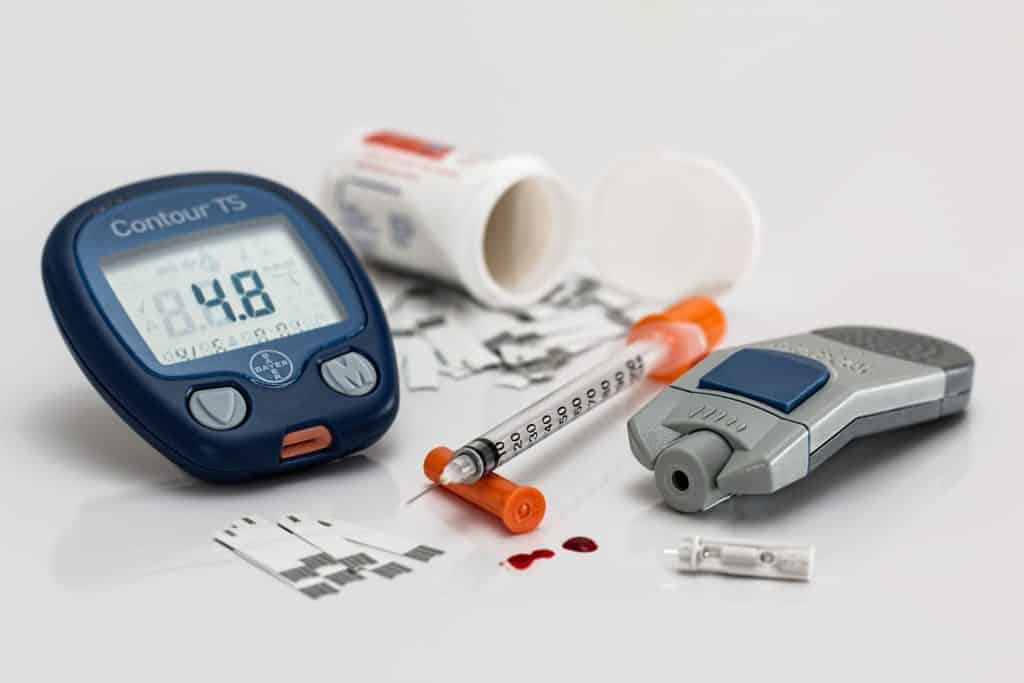Our son, Naylan, was diagnosed with Type 1 Diabetes (T1D) six months ago, just before his third birthday. Since that time, I have had several people ask various questions about life with T1D. In this post, I will answer the most frequently asked questions (FAQs) I have received. I will also share the struggles I am facing as the primary caregiver of a child with T1D. I hope this post 1) increases your awareness and understanding of T1D, 2) provides insight into the activities required to manage it, 3) helps you understand some of the challenges T1D families face, and 4) offers encouragement to those who are walking through a difficult situation, too.
About Naylan’s Diabetes
How did you find out that Naylan has diabetes?
A little over a month before his third birthday, I started noticing that Naylan wanted more than his usual amount of milk to drink. I initially thought he was going through a finicky toddler phase, but when he became desperate for ANYTHING he could find to drink, I knew something was not right. Click here to read more about his diagnosis.
Have the doctors determined what caused Naylan’s diabetes? Will he ever outgrow it, or can it go away with diet or lifestyle changes?
T1D is a chronic autoimmune disease where a person’s immune system attacks and destroys insulin-producing cells in the pancreas. This attack causes the pancreas to no longer produce insulin, which is a hormone needed to regulate blood sugar. Without insulin, the body cannot break down sugar from carbohydrates to be used as energy. If the sugar stays in the blood, it can become toxic, cause severe damage to other organs, and become life-threatening. Therefore, people with T1D are insulin-dependent, meaning that for the rest of their lives, they must have insulin injected into their bodies multiple times a day to survive.
Although ongoing research is being performed (and has been for years), there is currently no cure for T1D. Researchers believe that hereditary and environmental factors contribute to the development of T1D, but exact causes are not known. However, researchers do know that a person’s diet, activity levels, and habits do not contribute to the development of the disease. There is nothing a person can do to prevent it.
“T1D is NOT a lifestyle disease, it isn’t contagious or something you can outgrow, and it’s not preventable, curable or caused by eating too much sugar.”
How We Manage T1D
Is Naylan required to be on a certain diet, and does he have any food restrictions?
No, Naylan is not required to be on a specific diet. He is free to eat a variety of foods, including sweets (in moderation), but he is limited to WHEN he can eat and HOW MUCH he can eat. He is encouraged to eat a healthy, balanced diet (just as a normal, healthy person should) to maintain optimal health. This means eating foods from all food groups, including carbohydrates because he needs them for energy. However, he cannot drink sugary drinks (like fruit juices and sodas) unless they are used to treat abnormal blood sugars. Those types of drinks elevate blood sugar levels quickly. Planning his meals and snacks is KEY to managing his diabetes.

What does day-to-day management of Naylan’s diabetes entail?
Managing T1D requires detailed planning and treatment to ensure Naylan’s blood sugar stays within a healthy range to avoid life-threatening situations. It is a non-stop balancing act of finger pricks, insulin injections, dosage calculations, carb counting, monitoring activity levels and behavior, and so much more. At a minimum, daily management includes the following:
- Monitoring Blood Sugar
Naylan’s blood sugar is impacted by every bite or sip he takes, his activity levels (e.g., playing, exercise, sleep), illness, weather, and many other factors. Therefore, we monitor it throughout the day with finger pricks to try to keep it within his target range. This helps us avoid severe highs (which can cause long-term organ damage) and severe lows (that can be life-threatening). We are required to check it at least four times every day (at breakfast, lunch, dinner, and bedtime). However, we also check it if it appears high or low, before rigorous playtime, if he’s sick, and even sometimes during the night. We track his blood sugar readings in a log so that we can assess patterns of highs and lows. Patterns indicate that changes are needed to his insulin dosage calculations and signal us to contact his endocrinology team so that adjustments can be made. - Administering Insulin
Naylan takes at least four insulin shots everyday. We inject a “long-acting” insulin at the start of each day that works throughout the day to maintain his blood sugar levels. We also inject a “short-acting” insulin after each meal (and sometimes snacks) that works to regulate his blood sugar more quickly and for a certain time frame after eating. He may also need insulin at other times throughout the day if his blood sugar is high (e.g., at bedtime or in between meals that are spaced more than three hours apart).
“Insulin is not a cure for diabetes: it is a treatment that keeps people with diabetes alive.” -JDRF - Counting Carbohydrates (or “Carbs”)
The amount of insulin Naylan receives after each meal (or snack) is determined by the amount of carbs he eats. That means we have to count the carbs for everything he eats and drinks. Giving him too much or too little insulin can be harmful and even life-threatening. Therefore, we have to know E-V-E-R-Y-THING that goes into his mouth so that we are as accurate as possible with carb counting. (This includes watching him carefully so that he does not sneak food or drink without our knowledge, which has happened a couple of times.)
Carb counting becomes even more challenging when eating foods prepared outside of our home. Thankfully, there are apps that track carbs in items served at most restaurants today. Reviewing menus ahead of time to plan what and how much Naylan eats helps us prepare. Going to birthday parties and family gatherings also requires extra planning and coordination ahead of time. We coordinate with hosts to know the types of foods that will be served, the timing of meals, etc. This helps to ensure that Naylan can eat meals and enjoy treats along with everyone else. - Monitoring Activity & Behavior Throughout the Day
Naylan is an active, growing three-year-old, so his blood sugar fluctuates throughout the day. Therefore, we monitor his behavior, moods, and activities throughout the day for signs of low and high blood sugars so they can be treated timely. We have been educated on what the signs of each could look like, but Naylan does not always exhibit those symptoms. Additionally, because of his age, he is not always able to communicate how he physically feels. Over time though, I have noticed that he asks for “juice” (which is really sugar-free Gatorade) when his sugar is trending higher. Likewise, when his sugar is trending low, he sometimes will begin to act sleepy by nodding off and shortly waking.
There are specific procedures we follow to treat highs and lows. Once treated, we continue to monitor until his blood sugar adjusts to the target range. The procedures are very prescriptive and are based on the degree of the high or the low. I keep a folder of instructions with me and have them posted in the kitchen to help me keep it all together!
- Working with Endocrinology Team
Even when following all of the prescribed management activities, T1D patients can still have wacky blood sugar levels. This could result from a number of factors, including sensitivity to insulin, age, growth spurts, effects of different foods on the blood sugar, etc. Therefore, we work very closely with Naylan’s endocrinology team on a continuous basis (several times a month) to adjust his T1D management plan. We also attend regularly scheduled check-ups every three months and education classes, as needed.
Side note: When I say endocrinology “team,” I am not at all exaggerating! We are extremely blessed to have doctors, nurses, diabetes educators, counselors, dieticians, and social workers at our disposal to help us navigate life with T1D. It gives me so much comfort to have all of these resources available to us whenever we need them.
- Managing Diabetes Supplies/Medications and Preparing for Sickness and Emergencies
There are a number of medications and supplies we use every day to manage Naylan’s diabetes. There are also medications and supplies we keep on hand to treat high/low blood sugar levels and to manage sick days (even the common cold). This requires tracking expiration dates and inventory levels so we know when to call the pharmacy for refills. We also keep extra supplies on hand for emergencies (such as natural disasters or power outages).
How Our Family Is Coping with T1D
How is Naylan coping with having diabetes?
The initial diagnosis and subsequent hospital stay were pretty traumatic for Naylan. He was bombarded with IV needles, finger pricks, and insulin injections all within a matter of moments. Just as he was getting used to the nurses poking him, his dad and I had to practice doing pokes and injections. That crushed him (as it did us). After a day or two of constant pricks and pokes, he started handling it all with such bravery. Before we left the hospital, he was voluntarily handing me his hand for finger pricks. Now, he treats it all like normal course of business, with no fighting or hesitation. He will even ask to have his blood sugar checked when he’s ready for a meal. We are grateful that he has adjusted so quickly and with such ease.

How are Naylan’s dad and sisters handling his diagnosis?
Naylan’s dad was initially shocked and saddened by the diagnosis. However, he is tough and jumped right into learning how to manage T1D to help Naylan stay healthy. He is always watching Naylan and asking him if he feels okay. He’s a pro at checking blood sugar and giving insulin injections!
All three of Naylan’s sisters have been very supportive through this entire transition. Of course, his two older sisters were concerned about him when he was initially diagnosed. Since they have seen for themselves that he is okay and responding to treatment without a struggle, they are fine. Over the past couple of months, they have been learning how to check his blood sugar and give insulin injections. Now they are able to do both pretty much by themselves. They call themselves my nursing assistants! They are tremendous helpers. Naylan’s two-year-old sister is his cheerleader and best friend. She helps me make sure I give Naylan the right amount of insulin by repeating dosage units to me. She even practices checking blood sugar on her stuffed animals! My Mommy-heart is grateful. God has graciously blessed us with some exceptional children.
How are you doing with all of this?
Honestly, it depends on the day! I am so grateful that Naylan is doing well and we’re able to manage his diabetes. I try to count my blessings and give thanks for them each day. But to be quite honest, I still struggle to keep it together every day. Some days are calm, and some days are HARD.
Being the primary caregiver of a small child with T1D, along with my other responsibilities, is very challenging and overwhelming. T1D impacts everything we do, from eating and sleeping to activities and traveling (whether it’s a quick run to the store or a longer trip to visit family). Even when I’m not physically doing something to manage it, it’s on my mind…not because I’m worried or anxious, but because it requires constant planning, monitoring, and attention.
In full transparency, I have been battling mental health issues since Naylan’s diagnosis. I struggle with anxiety when it comes to cooking meals and taking Naylan away from home. There are so many things to consider and remember that the meticulous planning and preparation overwhelm me. I also experienced mild depression about four months after Naylan’s diagnosis. It resulted from caregiver burnout and feeling like I was alone in what I experience as a caregiver. I have even been confronted with grief. I have grieved the loss of the carefree life Naylan had before his diagnosis and the reality that his everyday life now consists of multiple pricks and pokes. I’ve also grieved not having my mother‘s guidance, encouragement, and support through this major life transition. I did not recognize these issues existed at first because I just kept going. But it was only so long before they were obvious, and I realized that I needed help. I started counseling with a therapist and am currently working through these emotional challenges. I’m learning to take it one day, one moment at a time. And I’m learning to simply BREATHE. I’m also very grateful for the love of family and friends who encourage and pray for me.
(If you want to learn more on how to support a T1D family, click here.)

Encouraging You as I Encourage Myself
I share all of this because I know that I’m not the only one walking through a hard, challenging season. Sister, I know you have your own struggles, too. And I want you to know that YOU ARE NOT ALONE. I want to encourage you (while I encourage myself) to look to the One who keeps you.
Acknowledging where we are physically, mentally, emotionally, and spiritually is key to enduring our struggles. When we are honest about our humanness as we go through difficult times, we open ourselves up to receive God’s comfort and strength. I often think about the many Psalms that David wrote expressing his fears, his worries, and his anguish. I even think about Jesus as He agonized in the Garden of Gethsemane before his crucifixion. He admitted that His flesh was weak…that He did not want to go through with death on a cross. Yet, in their honesty, they surrendered their humanness to God. After David vented his feelings, He expressed His trust and belief in God. And Jesus surrendered His will for the will of the Father.
I am also reminded of Paul and his thorn in the flesh (see 2 Corinthians 12). The Bible does not tell us what his “thorn” was. We do know, however, that it was bad enough for Paul to request THREE TIMES that it be removed. Yet, in all of Paul’s pleading, Jesus did not take the thorn away. Instead, he said to him, “My grace is sufficient for you, for My strength is made perfect in weakness.” (2 Corinthians 12:9a, NKJV). Jesus’ grace was enough to get Paul through his hard thing. He would literally pour out His own strength on Paul so that he had power to endure. And sis, that same promise is available to you and me.
If you are like me and find yourself in a situation that you will have to endure for now, let this truth sink way down into the depths of your soul: HIS GRACE IS SUFFICIENT FOR YOU. Cling to that truth and allow His all-sufficient grace to carry you through your hard thing. He has the power to deliver us, but whether He will is up to Him. We can still choose to believe His promises and trust in His sustaining power. He’s kept us this far, and He won’t stop now. He’s A Keeper!
If you want to know more about Type 1 Diabetes, check out the links below:
- The Friends & Family Guide to Type 1 Diabetes – https://beyondtype1.org/the-friends-family-guide-to-type-1-diabetes/
- Warning Signs of Type 1 Diabetes – https://beyondtype1.org/warning-signs-of-type-1-diabetes/
- Type 1 Diabetes Facts – https://www.jdrf.org/t1d-resources/about/facts/
- Ways to Contribute to T1D Research – https://www.jdrf.org/donate/
If this blog post was helpful to you or you know someone who would benefit from reading it, feel free to share it. Also, leave a comment below or email me any thoughts or questions you have on this post. You can subscribe to my blog at the bottom of this page to receive notifications as other posts are published.



Pingback: Give Yourself Permission to Grieve - He's A Keeper
Pingback: 3 Practical Ways to Live Through Difficult Times - He's A Keeper